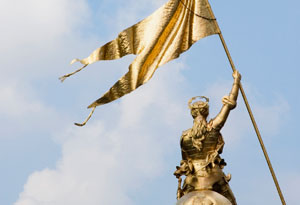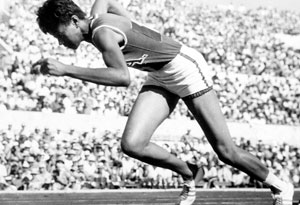
Photo: Thinkstock
600 B.C. TO 200 B.C.: Tribes of statuesque women (and men) roam the Eurasian steppes. The fearsome Amazons of myth? Not exactly. But archeological evidence suggests that among these nomads, the women were the warriors.
Circa 39: Dynamic sister duo Trung Trac and Trung Nhi amass a Vietnamese army in a revolt against Chinese rule. For four years, they lead the rebellion.
Circa 395: Fabiola, a Roman aristocrat whose divorce and subsequent remarriage were condemned by Christian society, founds a hospital for the poor and other outcasts of her city. It's likely one of the first hospitals in the Western world.
Circa 1001: Murasaki Shikibu begins writing The Tale of Genji, an epic portrait of court life (twice as long as War and Peace), considered by many to be the greatest masterpiece of Japanese literature and possibly the world's first novel.
1429: Peasant girl Joan of Arc commands the French army in a series of victorious battles to liberate her homeland from the English; she is burned at the stake for her trouble.
Circa 1579: Grace O'Malley, a swashbuckling Irish pirate known for raiding ships, fights off an English government expedition sent to stop her.
Circa 1613: In her graphically violent painting Judith Slaying Holofernes, Italian artist Artemisia Gentileschi slays the ideal of submissive womanhood: Her heroine is fierce, powerful, and ruthless.
1777: Teenager Sybil Ludington rides all night long through a storm to alert the 400 men in her father's militia that the redcoats are coming. She's called the female Paul Revere—but Paul rode with two of his buddies. And he was captured by the British.
1805: Sacagawea joins Lewis and Clark as their expedition's interpreter, traveling thousands of miles across the Rockies with her newborn babe strapped to her back. Who says life ends when you have kids?
1814: As the British torch Washington, D.C., First Lady Dolley Madison remains in the White House long enough to rescue historic valuables—running out moments before the soldiers charge in.
1862: Sarah Rosetta Wakeman, just 19 and dressed as a man, enlists in the Union Army. In a letter home, she assures: "I don't fear the rebel bullets nor I don't fear the cannon."
Circa 39: Dynamic sister duo Trung Trac and Trung Nhi amass a Vietnamese army in a revolt against Chinese rule. For four years, they lead the rebellion.
Circa 395: Fabiola, a Roman aristocrat whose divorce and subsequent remarriage were condemned by Christian society, founds a hospital for the poor and other outcasts of her city. It's likely one of the first hospitals in the Western world.
Circa 1001: Murasaki Shikibu begins writing The Tale of Genji, an epic portrait of court life (twice as long as War and Peace), considered by many to be the greatest masterpiece of Japanese literature and possibly the world's first novel.
1429: Peasant girl Joan of Arc commands the French army in a series of victorious battles to liberate her homeland from the English; she is burned at the stake for her trouble.
Circa 1579: Grace O'Malley, a swashbuckling Irish pirate known for raiding ships, fights off an English government expedition sent to stop her.
Circa 1613: In her graphically violent painting Judith Slaying Holofernes, Italian artist Artemisia Gentileschi slays the ideal of submissive womanhood: Her heroine is fierce, powerful, and ruthless.
1777: Teenager Sybil Ludington rides all night long through a storm to alert the 400 men in her father's militia that the redcoats are coming. She's called the female Paul Revere—but Paul rode with two of his buddies. And he was captured by the British.
1805: Sacagawea joins Lewis and Clark as their expedition's interpreter, traveling thousands of miles across the Rockies with her newborn babe strapped to her back. Who says life ends when you have kids?
1814: As the British torch Washington, D.C., First Lady Dolley Madison remains in the White House long enough to rescue historic valuables—running out moments before the soldiers charge in.
1862: Sarah Rosetta Wakeman, just 19 and dressed as a man, enlists in the Union Army. In a letter home, she assures: "I don't fear the rebel bullets nor I don't fear the cannon."
1867: Ida Lewis rescues three drowning men from wind-whipped swells in Newport Harbor. Then she rows back to save their sheep. Ida later becomes the country's first female lighthouse keeper.
1872: Victoria Claflin Woodhull becomes the first woman to run for president. A colorful candidate, she advocates for free love.
1906: Madam C.J. Walker hawks shampoos and serums door-to-door. The orphaned daughter of former slaves, she becomes one of America's wealthiest businesswomen.
1912: Astronomer Henrietta Swan Leavitt discovers the period-luminosity relationship (later used to calculate the distances between Earth and the stars).
1914: Barnstorming adrenaline junkie Georgia "Tiny" Broadwick makes the first-ever free fall from a plane.
1916: In a tenement neighborhood in Brooklyn, Margaret Sanger opens the doors of the country's first birth control clinic. Outside at least 150 women are waiting.
1916: Movie star Mary Pickford insists on becoming her own producer. America's Sweetheart is no sucker.
1937: Amelia Earhart disappears on the ultimate adventure—her attempt to fly around the globe. In a note to her husband, she explains: "I want to do it because I want to do it."
1938: Anna Mary Robertson Moses sells her first paintings, at age 78. Known as "Grandma" Moses, she continues to paint for 23 years, becoming one of the century's most renowned folk artists.
1941: Protofeminist superhero Wonder Woman first appears in a comic book, fighting off Fascists in star-spangled hot pants.
1946: Super-geekette Dorothy Hodgkin cracks penicillin's chemical makeup with an X-ray crystallographer. (Eighteen years later she'll earn the Nobel Prize.)
1872: Victoria Claflin Woodhull becomes the first woman to run for president. A colorful candidate, she advocates for free love.
1906: Madam C.J. Walker hawks shampoos and serums door-to-door. The orphaned daughter of former slaves, she becomes one of America's wealthiest businesswomen.
1912: Astronomer Henrietta Swan Leavitt discovers the period-luminosity relationship (later used to calculate the distances between Earth and the stars).
1914: Barnstorming adrenaline junkie Georgia "Tiny" Broadwick makes the first-ever free fall from a plane.
1916: In a tenement neighborhood in Brooklyn, Margaret Sanger opens the doors of the country's first birth control clinic. Outside at least 150 women are waiting.
1916: Movie star Mary Pickford insists on becoming her own producer. America's Sweetheart is no sucker.
1937: Amelia Earhart disappears on the ultimate adventure—her attempt to fly around the globe. In a note to her husband, she explains: "I want to do it because I want to do it."
1938: Anna Mary Robertson Moses sells her first paintings, at age 78. Known as "Grandma" Moses, she continues to paint for 23 years, becoming one of the century's most renowned folk artists.
1941: Protofeminist superhero Wonder Woman first appears in a comic book, fighting off Fascists in star-spangled hot pants.
1946: Super-geekette Dorothy Hodgkin cracks penicillin's chemical makeup with an X-ray crystallographer. (Eighteen years later she'll earn the Nobel Prize.)

Photo: Getty Images/Bob Thomas
1953: Jackie Cochran flies an F-86 Sabre jet through the sound barrier. She learned to fly so she could travel around selling cosmetics, but it turns out trashing speed records is a lot more fun.
1959: On the edge of the Serengeti Plain, Mary Leakey digs up and pieces together a 1.7-million-year-old hominid skull, one of the most important finds in the history of archeology.
1960: At the Rome Olympics, Wilma Rudolph (left)—once partially paralyzed by polio—earns three gold medals in track-and-field, the first American woman to do so.
1963: Soviet cosmonaut Valentina Tereshkova becomes the first female to fly a spacecraft around the globe.
1967: Kathrine Switzer dares to run the all-male Boston Marathon, while an irate race official chases her.
1981: Alexa Canady becomes the first black female neurosurgeon in the United States.
1985: Just 175 miles from the Iditarod finish line, Libby Riddles heads into a blizzard when other mushers opt to stay in camp; this gives her a six-hour lead and, ultimately, the win.
1989: Performance artist Karen Finley smears her body with chocolate to illustrate that women are treated like, you know, dirt. The National Endowment for the Arts rescinds her funding, but she ultimately gets it back.
2005: Roz Savage quits her corporate job, leaves her unraveling marriage, and rows across the Atlantic by herself. Midlife crisis averted.
2008: Sandra Andersen, a barista at a Starbucks in Tacoma, Washington, learns that one of her customers needs a kidney to live. So she gives the woman hers.
2009: Navigator Ann Daniels leads the Catlin Arctic Survey, a 74-day journey from the Arctic Ocean to the North Pole to measure the thickness of sea ice.
9 real-life big adventures, plus, how to have your own
1959: On the edge of the Serengeti Plain, Mary Leakey digs up and pieces together a 1.7-million-year-old hominid skull, one of the most important finds in the history of archeology.
1960: At the Rome Olympics, Wilma Rudolph (left)—once partially paralyzed by polio—earns three gold medals in track-and-field, the first American woman to do so.
1963: Soviet cosmonaut Valentina Tereshkova becomes the first female to fly a spacecraft around the globe.
1967: Kathrine Switzer dares to run the all-male Boston Marathon, while an irate race official chases her.
1981: Alexa Canady becomes the first black female neurosurgeon in the United States.
1985: Just 175 miles from the Iditarod finish line, Libby Riddles heads into a blizzard when other mushers opt to stay in camp; this gives her a six-hour lead and, ultimately, the win.
1989: Performance artist Karen Finley smears her body with chocolate to illustrate that women are treated like, you know, dirt. The National Endowment for the Arts rescinds her funding, but she ultimately gets it back.
2005: Roz Savage quits her corporate job, leaves her unraveling marriage, and rows across the Atlantic by herself. Midlife crisis averted.
2008: Sandra Andersen, a barista at a Starbucks in Tacoma, Washington, learns that one of her customers needs a kidney to live. So she gives the woman hers.
2009: Navigator Ann Daniels leads the Catlin Arctic Survey, a 74-day journey from the Arctic Ocean to the North Pole to measure the thickness of sea ice.
9 real-life big adventures, plus, how to have your own




